Evaluating the Maori Health Strategy: Initiatives and Outcomes
VerifiedAdded on 2023/06/03
|9
|2258
|296
Report
AI Summary
This report provides an analysis of the Maori Health Strategy in New Zealand, highlighting its aim to address the unique health needs of the Maori people and reduce health disparities. It compares the Maori Health Strategy with the broader New Zealand Health Strategy, noting their similarities and the Maori strategy's specific focus on cultural context and equitable access to healthcare. The report discusses initiatives such as the collaboration between Auckland and Waitemata district health boards (He Kamaka Waiora) and their Maori for Maori planning approach to improve health outcomes. It emphasizes the importance of health equity and self-determination in achieving the strategy's goals, ultimately aiming to bridge the health gap between the Maori and non-Maori populations in New Zealand.
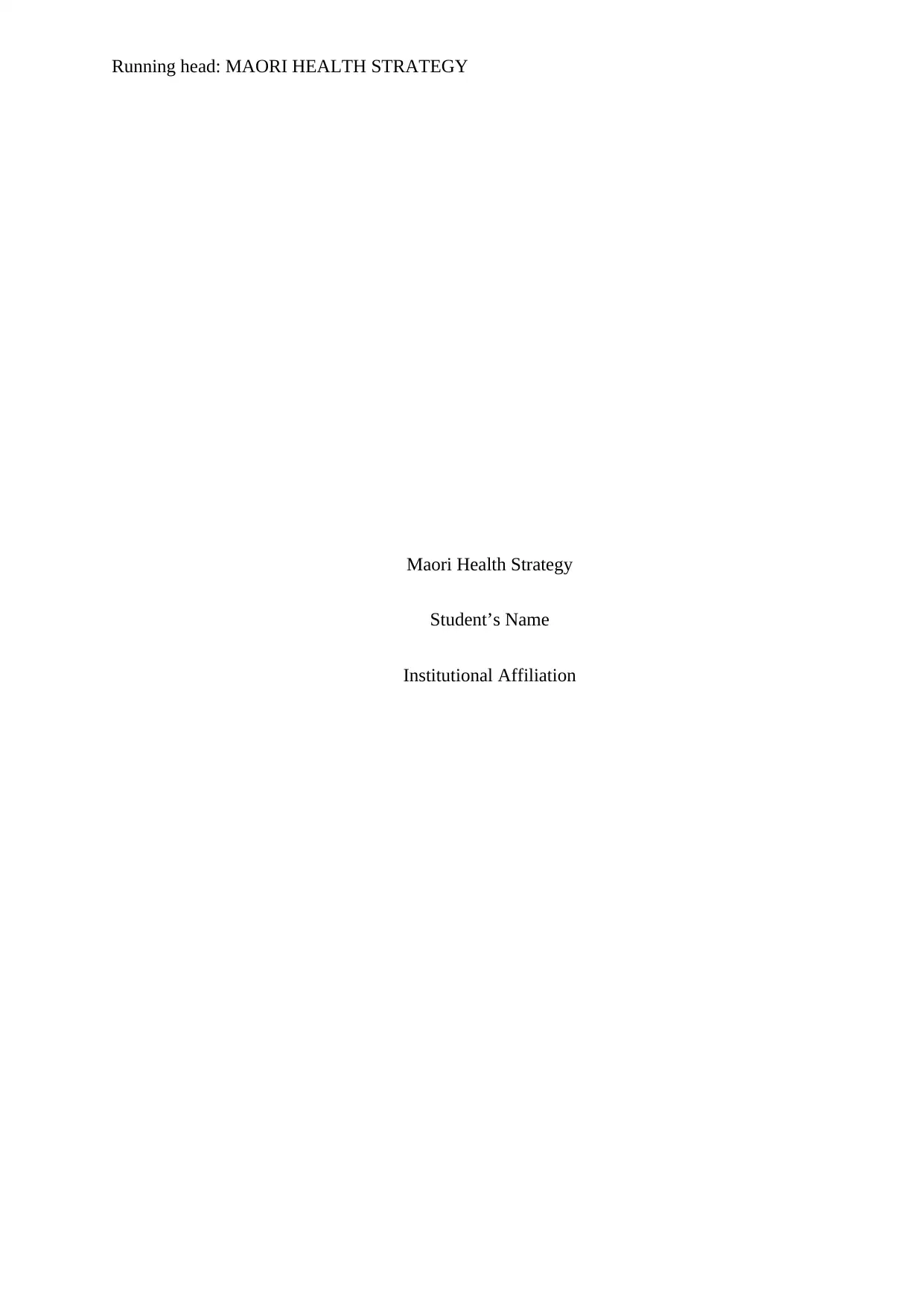
Running head: MAORI HEALTH STRATEGY
Maori Health Strategy
Student’s Name
Institutional Affiliation
Maori Health Strategy
Student’s Name
Institutional Affiliation
Paraphrase This Document
Need a fresh take? Get an instant paraphrase of this document with our AI Paraphraser
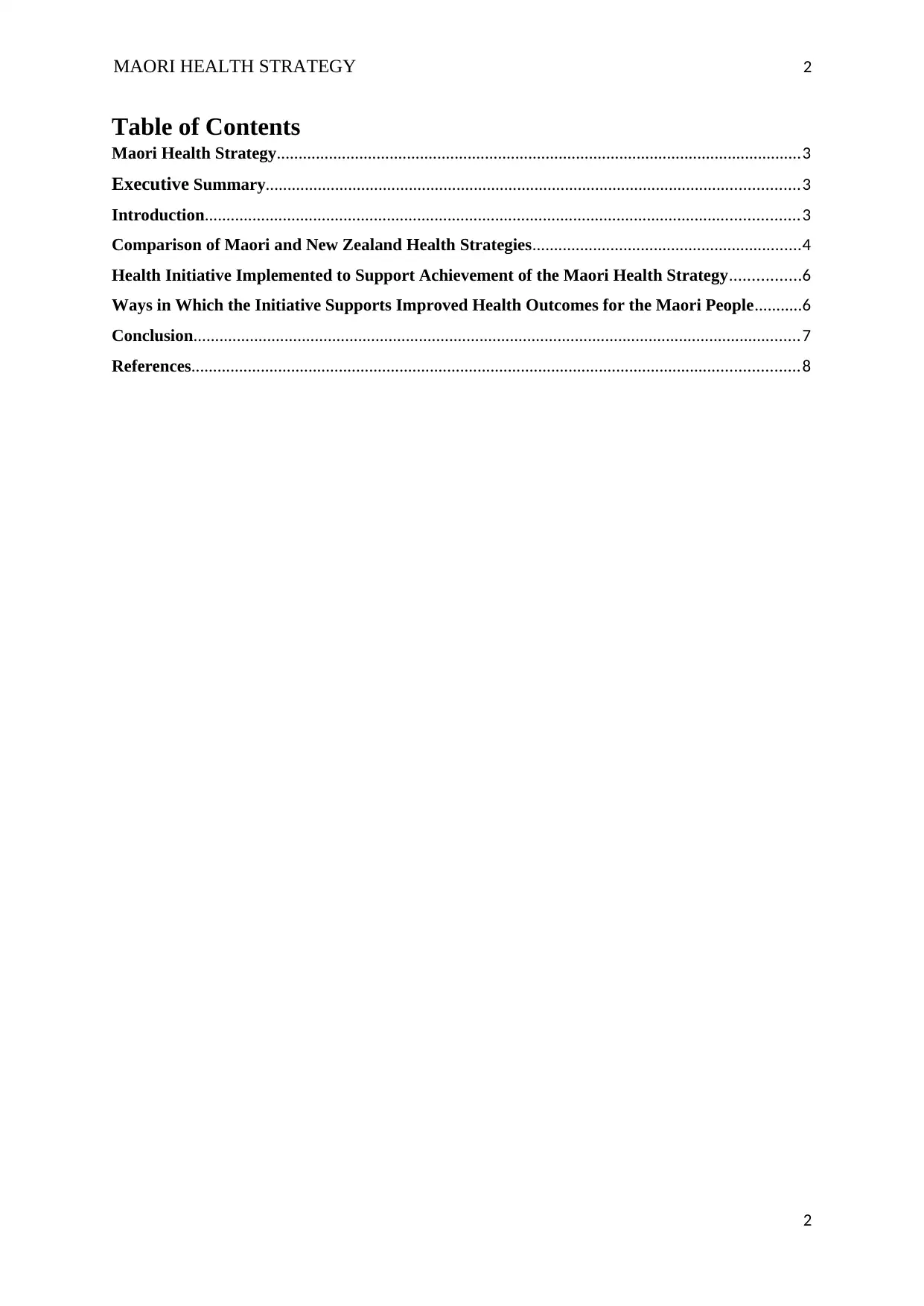
MAORI HEALTH STRATEGY 2
Table of Contents
Maori Health Strategy.........................................................................................................................3
Executive Summary...........................................................................................................................3
Introduction.........................................................................................................................................3
Comparison of Maori and New Zealand Health Strategies..............................................................4
Health Initiative Implemented to Support Achievement of the Maori Health Strategy................6
Ways in Which the Initiative Supports Improved Health Outcomes for the Maori People...........6
Conclusion............................................................................................................................................7
References............................................................................................................................................8
2
Table of Contents
Maori Health Strategy.........................................................................................................................3
Executive Summary...........................................................................................................................3
Introduction.........................................................................................................................................3
Comparison of Maori and New Zealand Health Strategies..............................................................4
Health Initiative Implemented to Support Achievement of the Maori Health Strategy................6
Ways in Which the Initiative Supports Improved Health Outcomes for the Maori People...........6
Conclusion............................................................................................................................................7
References............................................................................................................................................8
2
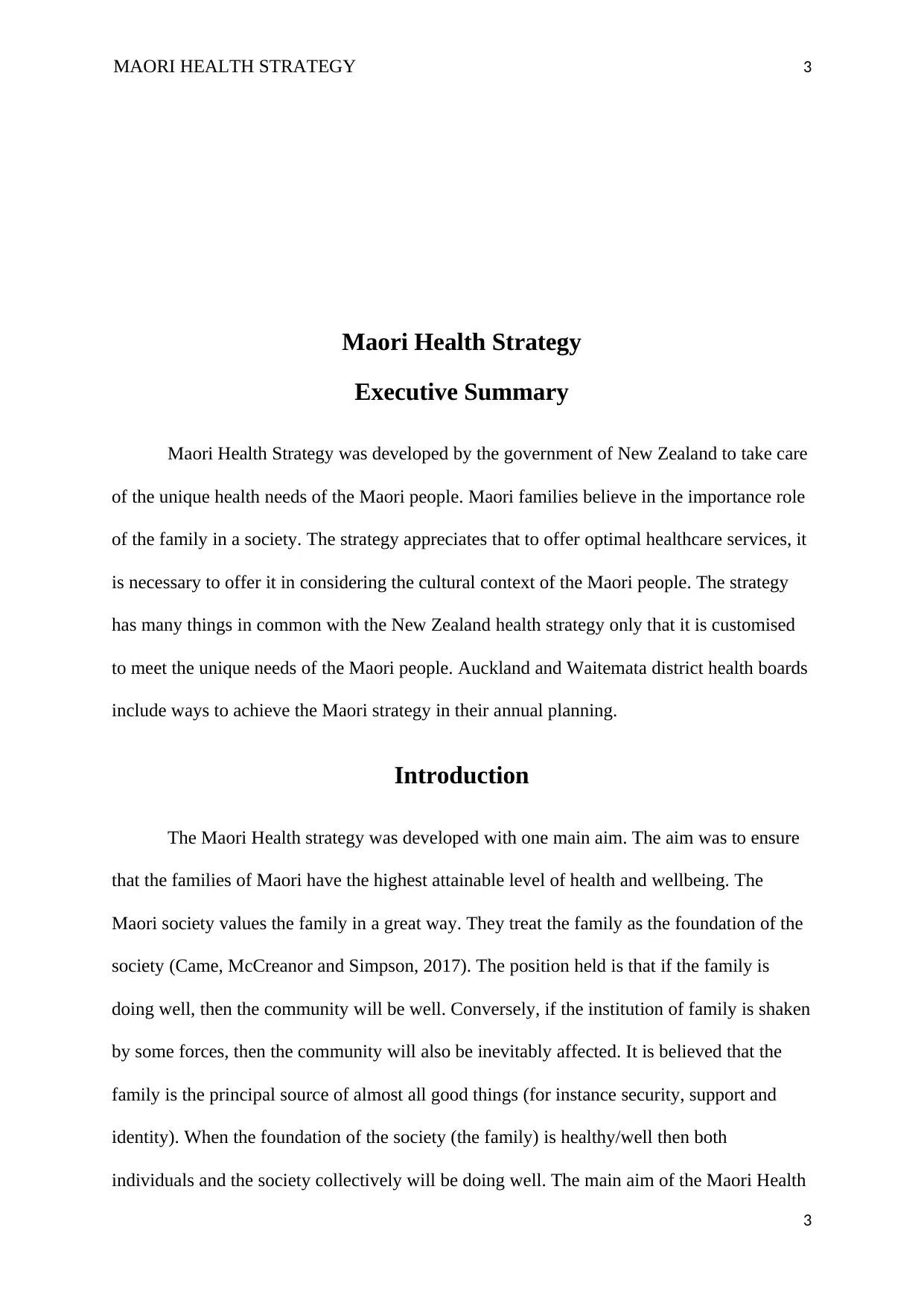
MAORI HEALTH STRATEGY 3
Maori Health Strategy
Executive Summary
Maori Health Strategy was developed by the government of New Zealand to take care
of the unique health needs of the Maori people. Maori families believe in the importance role
of the family in a society. The strategy appreciates that to offer optimal healthcare services, it
is necessary to offer it in considering the cultural context of the Maori people. The strategy
has many things in common with the New Zealand health strategy only that it is customised
to meet the unique needs of the Maori people. Auckland and Waitemata district health boards
include ways to achieve the Maori strategy in their annual planning.
Introduction
The Maori Health strategy was developed with one main aim. The aim was to ensure
that the families of Maori have the highest attainable level of health and wellbeing. The
Maori society values the family in a great way. They treat the family as the foundation of the
society (Came, McCreanor and Simpson, 2017). The position held is that if the family is
doing well, then the community will be well. Conversely, if the institution of family is shaken
by some forces, then the community will also be inevitably affected. It is believed that the
family is the principal source of almost all good things (for instance security, support and
identity). When the foundation of the society (the family) is healthy/well then both
individuals and the society collectively will be doing well. The main aim of the Maori Health
3
Maori Health Strategy
Executive Summary
Maori Health Strategy was developed by the government of New Zealand to take care
of the unique health needs of the Maori people. Maori families believe in the importance role
of the family in a society. The strategy appreciates that to offer optimal healthcare services, it
is necessary to offer it in considering the cultural context of the Maori people. The strategy
has many things in common with the New Zealand health strategy only that it is customised
to meet the unique needs of the Maori people. Auckland and Waitemata district health boards
include ways to achieve the Maori strategy in their annual planning.
Introduction
The Maori Health strategy was developed with one main aim. The aim was to ensure
that the families of Maori have the highest attainable level of health and wellbeing. The
Maori society values the family in a great way. They treat the family as the foundation of the
society (Came, McCreanor and Simpson, 2017). The position held is that if the family is
doing well, then the community will be well. Conversely, if the institution of family is shaken
by some forces, then the community will also be inevitably affected. It is believed that the
family is the principal source of almost all good things (for instance security, support and
identity). When the foundation of the society (the family) is healthy/well then both
individuals and the society collectively will be doing well. The main aim of the Maori Health
3
⊘ This is a preview!⊘
Do you want full access?
Subscribe today to unlock all pages.

Trusted by 1+ million students worldwide
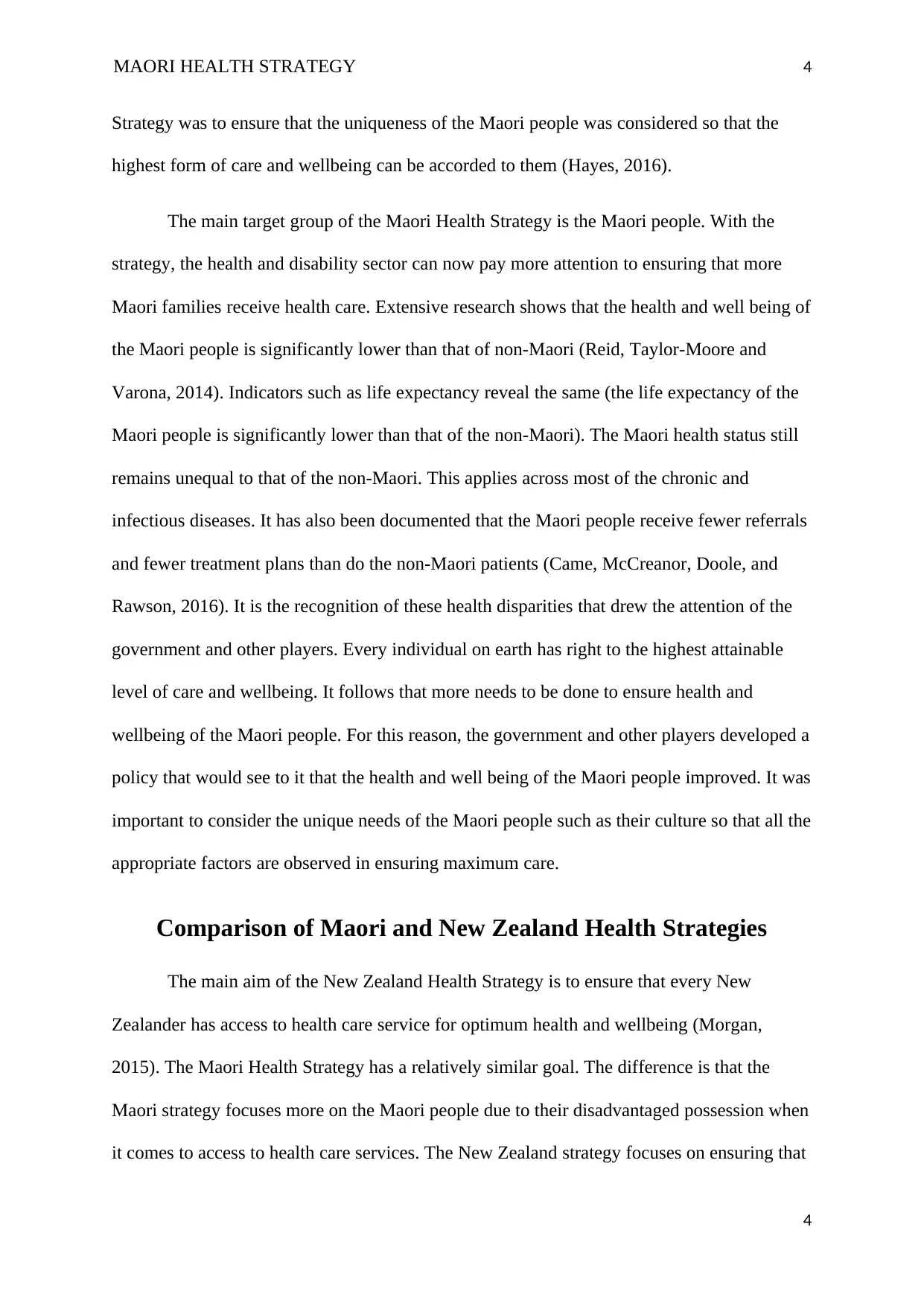
MAORI HEALTH STRATEGY 4
Strategy was to ensure that the uniqueness of the Maori people was considered so that the
highest form of care and wellbeing can be accorded to them (Hayes, 2016).
The main target group of the Maori Health Strategy is the Maori people. With the
strategy, the health and disability sector can now pay more attention to ensuring that more
Maori families receive health care. Extensive research shows that the health and well being of
the Maori people is significantly lower than that of non-Maori (Reid, Taylor-Moore and
Varona, 2014). Indicators such as life expectancy reveal the same (the life expectancy of the
Maori people is significantly lower than that of the non-Maori). The Maori health status still
remains unequal to that of the non-Maori. This applies across most of the chronic and
infectious diseases. It has also been documented that the Maori people receive fewer referrals
and fewer treatment plans than do the non-Maori patients (Came, McCreanor, Doole, and
Rawson, 2016). It is the recognition of these health disparities that drew the attention of the
government and other players. Every individual on earth has right to the highest attainable
level of care and wellbeing. It follows that more needs to be done to ensure health and
wellbeing of the Maori people. For this reason, the government and other players developed a
policy that would see to it that the health and well being of the Maori people improved. It was
important to consider the unique needs of the Maori people such as their culture so that all the
appropriate factors are observed in ensuring maximum care.
Comparison of Maori and New Zealand Health Strategies
The main aim of the New Zealand Health Strategy is to ensure that every New
Zealander has access to health care service for optimum health and wellbeing (Morgan,
2015). The Maori Health Strategy has a relatively similar goal. The difference is that the
Maori strategy focuses more on the Maori people due to their disadvantaged possession when
it comes to access to health care services. The New Zealand strategy focuses on ensuring that
4
Strategy was to ensure that the uniqueness of the Maori people was considered so that the
highest form of care and wellbeing can be accorded to them (Hayes, 2016).
The main target group of the Maori Health Strategy is the Maori people. With the
strategy, the health and disability sector can now pay more attention to ensuring that more
Maori families receive health care. Extensive research shows that the health and well being of
the Maori people is significantly lower than that of non-Maori (Reid, Taylor-Moore and
Varona, 2014). Indicators such as life expectancy reveal the same (the life expectancy of the
Maori people is significantly lower than that of the non-Maori). The Maori health status still
remains unequal to that of the non-Maori. This applies across most of the chronic and
infectious diseases. It has also been documented that the Maori people receive fewer referrals
and fewer treatment plans than do the non-Maori patients (Came, McCreanor, Doole, and
Rawson, 2016). It is the recognition of these health disparities that drew the attention of the
government and other players. Every individual on earth has right to the highest attainable
level of care and wellbeing. It follows that more needs to be done to ensure health and
wellbeing of the Maori people. For this reason, the government and other players developed a
policy that would see to it that the health and well being of the Maori people improved. It was
important to consider the unique needs of the Maori people such as their culture so that all the
appropriate factors are observed in ensuring maximum care.
Comparison of Maori and New Zealand Health Strategies
The main aim of the New Zealand Health Strategy is to ensure that every New
Zealander has access to health care service for optimum health and wellbeing (Morgan,
2015). The Maori Health Strategy has a relatively similar goal. The difference is that the
Maori strategy focuses more on the Maori people due to their disadvantaged possession when
it comes to access to health care services. The New Zealand strategy focuses on ensuring that
4
Paraphrase This Document
Need a fresh take? Get an instant paraphrase of this document with our AI Paraphraser
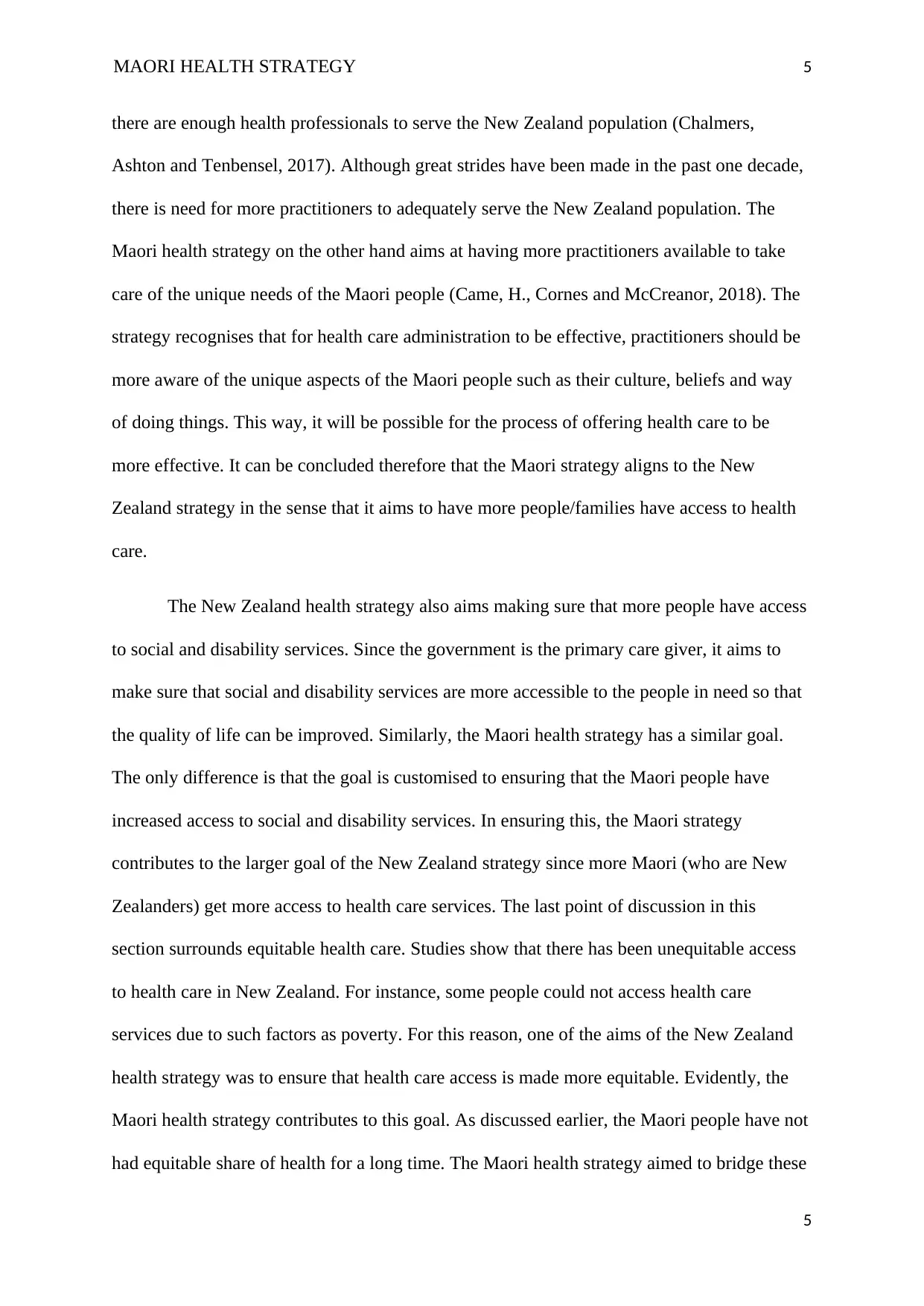
MAORI HEALTH STRATEGY 5
there are enough health professionals to serve the New Zealand population (Chalmers,
Ashton and Tenbensel, 2017). Although great strides have been made in the past one decade,
there is need for more practitioners to adequately serve the New Zealand population. The
Maori health strategy on the other hand aims at having more practitioners available to take
care of the unique needs of the Maori people (Came, H., Cornes and McCreanor, 2018). The
strategy recognises that for health care administration to be effective, practitioners should be
more aware of the unique aspects of the Maori people such as their culture, beliefs and way
of doing things. This way, it will be possible for the process of offering health care to be
more effective. It can be concluded therefore that the Maori strategy aligns to the New
Zealand strategy in the sense that it aims to have more people/families have access to health
care.
The New Zealand health strategy also aims making sure that more people have access
to social and disability services. Since the government is the primary care giver, it aims to
make sure that social and disability services are more accessible to the people in need so that
the quality of life can be improved. Similarly, the Maori health strategy has a similar goal.
The only difference is that the goal is customised to ensuring that the Maori people have
increased access to social and disability services. In ensuring this, the Maori strategy
contributes to the larger goal of the New Zealand strategy since more Maori (who are New
Zealanders) get more access to health care services. The last point of discussion in this
section surrounds equitable health care. Studies show that there has been unequitable access
to health care in New Zealand. For instance, some people could not access health care
services due to such factors as poverty. For this reason, one of the aims of the New Zealand
health strategy was to ensure that health care access is made more equitable. Evidently, the
Maori health strategy contributes to this goal. As discussed earlier, the Maori people have not
had equitable share of health for a long time. The Maori health strategy aimed to bridge these
5
there are enough health professionals to serve the New Zealand population (Chalmers,
Ashton and Tenbensel, 2017). Although great strides have been made in the past one decade,
there is need for more practitioners to adequately serve the New Zealand population. The
Maori health strategy on the other hand aims at having more practitioners available to take
care of the unique needs of the Maori people (Came, H., Cornes and McCreanor, 2018). The
strategy recognises that for health care administration to be effective, practitioners should be
more aware of the unique aspects of the Maori people such as their culture, beliefs and way
of doing things. This way, it will be possible for the process of offering health care to be
more effective. It can be concluded therefore that the Maori strategy aligns to the New
Zealand strategy in the sense that it aims to have more people/families have access to health
care.
The New Zealand health strategy also aims making sure that more people have access
to social and disability services. Since the government is the primary care giver, it aims to
make sure that social and disability services are more accessible to the people in need so that
the quality of life can be improved. Similarly, the Maori health strategy has a similar goal.
The only difference is that the goal is customised to ensuring that the Maori people have
increased access to social and disability services. In ensuring this, the Maori strategy
contributes to the larger goal of the New Zealand strategy since more Maori (who are New
Zealanders) get more access to health care services. The last point of discussion in this
section surrounds equitable health care. Studies show that there has been unequitable access
to health care in New Zealand. For instance, some people could not access health care
services due to such factors as poverty. For this reason, one of the aims of the New Zealand
health strategy was to ensure that health care access is made more equitable. Evidently, the
Maori health strategy contributes to this goal. As discussed earlier, the Maori people have not
had equitable share of health for a long time. The Maori health strategy aimed to bridge these
5
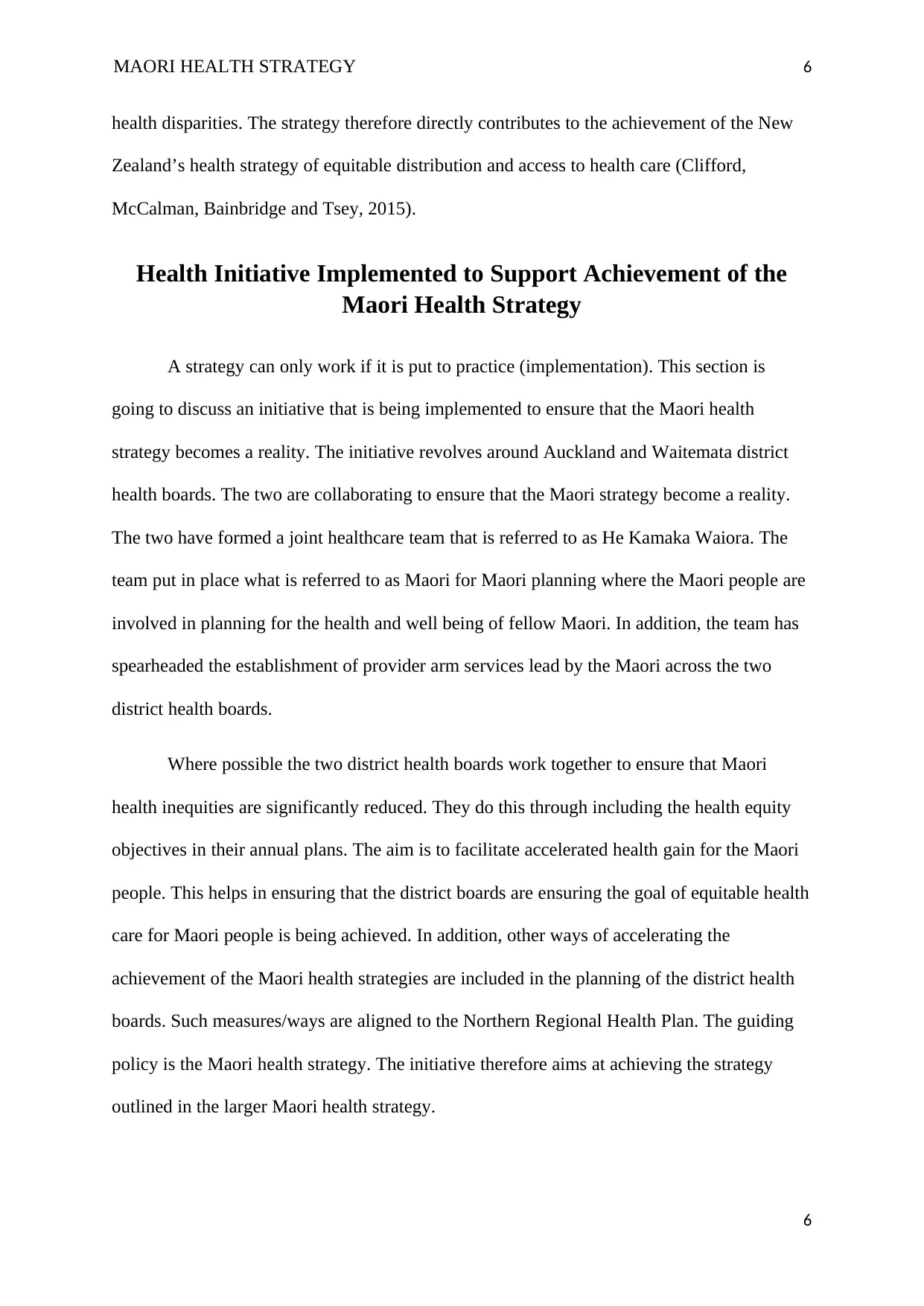
MAORI HEALTH STRATEGY 6
health disparities. The strategy therefore directly contributes to the achievement of the New
Zealand’s health strategy of equitable distribution and access to health care (Clifford,
McCalman, Bainbridge and Tsey, 2015).
Health Initiative Implemented to Support Achievement of the
Maori Health Strategy
A strategy can only work if it is put to practice (implementation). This section is
going to discuss an initiative that is being implemented to ensure that the Maori health
strategy becomes a reality. The initiative revolves around Auckland and Waitemata district
health boards. The two are collaborating to ensure that the Maori strategy become a reality.
The two have formed a joint healthcare team that is referred to as He Kamaka Waiora. The
team put in place what is referred to as Maori for Maori planning where the Maori people are
involved in planning for the health and well being of fellow Maori. In addition, the team has
spearheaded the establishment of provider arm services lead by the Maori across the two
district health boards.
Where possible the two district health boards work together to ensure that Maori
health inequities are significantly reduced. They do this through including the health equity
objectives in their annual plans. The aim is to facilitate accelerated health gain for the Maori
people. This helps in ensuring that the district boards are ensuring the goal of equitable health
care for Maori people is being achieved. In addition, other ways of accelerating the
achievement of the Maori health strategies are included in the planning of the district health
boards. Such measures/ways are aligned to the Northern Regional Health Plan. The guiding
policy is the Maori health strategy. The initiative therefore aims at achieving the strategy
outlined in the larger Maori health strategy.
6
health disparities. The strategy therefore directly contributes to the achievement of the New
Zealand’s health strategy of equitable distribution and access to health care (Clifford,
McCalman, Bainbridge and Tsey, 2015).
Health Initiative Implemented to Support Achievement of the
Maori Health Strategy
A strategy can only work if it is put to practice (implementation). This section is
going to discuss an initiative that is being implemented to ensure that the Maori health
strategy becomes a reality. The initiative revolves around Auckland and Waitemata district
health boards. The two are collaborating to ensure that the Maori strategy become a reality.
The two have formed a joint healthcare team that is referred to as He Kamaka Waiora. The
team put in place what is referred to as Maori for Maori planning where the Maori people are
involved in planning for the health and well being of fellow Maori. In addition, the team has
spearheaded the establishment of provider arm services lead by the Maori across the two
district health boards.
Where possible the two district health boards work together to ensure that Maori
health inequities are significantly reduced. They do this through including the health equity
objectives in their annual plans. The aim is to facilitate accelerated health gain for the Maori
people. This helps in ensuring that the district boards are ensuring the goal of equitable health
care for Maori people is being achieved. In addition, other ways of accelerating the
achievement of the Maori health strategies are included in the planning of the district health
boards. Such measures/ways are aligned to the Northern Regional Health Plan. The guiding
policy is the Maori health strategy. The initiative therefore aims at achieving the strategy
outlined in the larger Maori health strategy.
6
⊘ This is a preview!⊘
Do you want full access?
Subscribe today to unlock all pages.

Trusted by 1+ million students worldwide
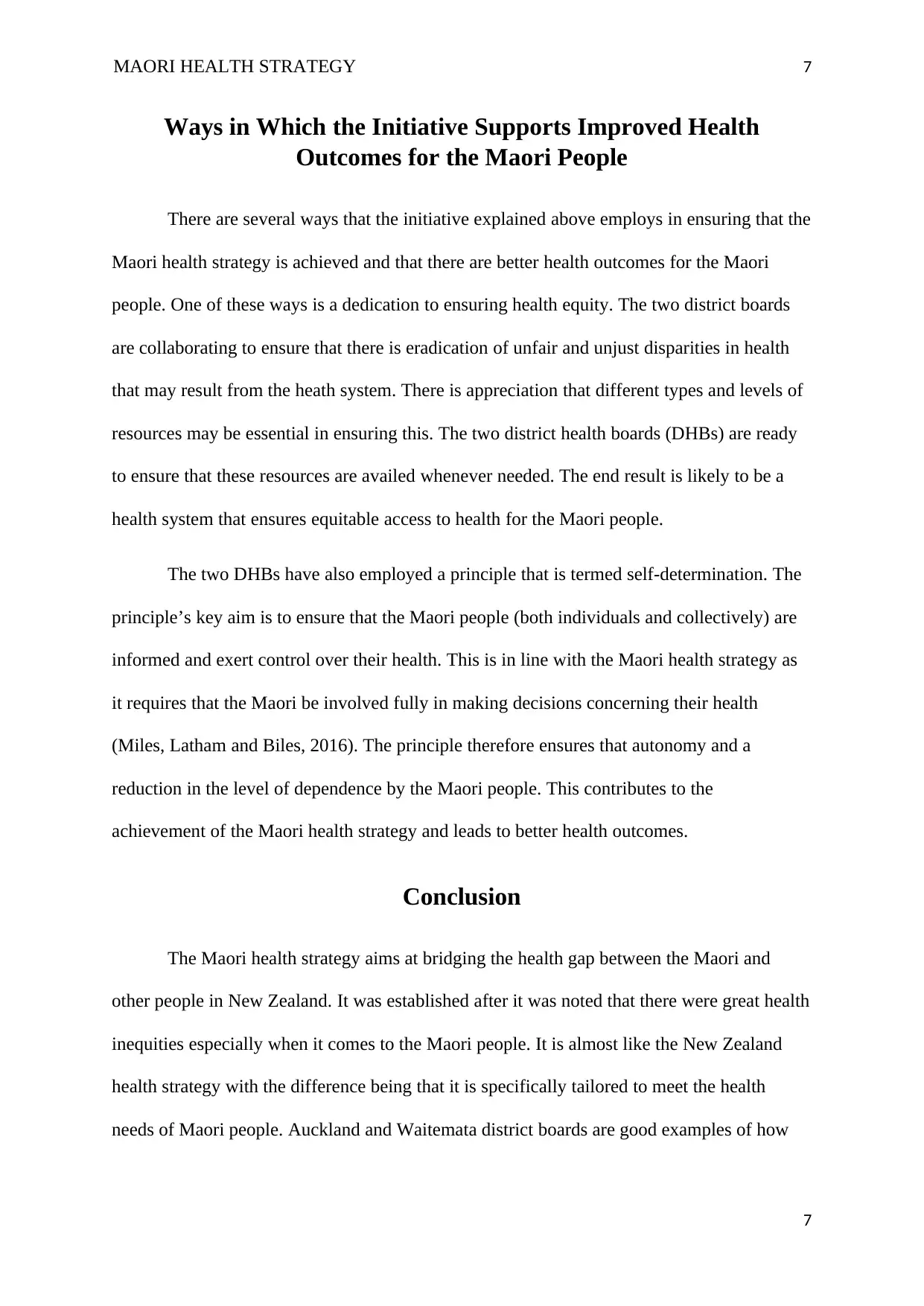
MAORI HEALTH STRATEGY 7
Ways in Which the Initiative Supports Improved Health
Outcomes for the Maori People
There are several ways that the initiative explained above employs in ensuring that the
Maori health strategy is achieved and that there are better health outcomes for the Maori
people. One of these ways is a dedication to ensuring health equity. The two district boards
are collaborating to ensure that there is eradication of unfair and unjust disparities in health
that may result from the heath system. There is appreciation that different types and levels of
resources may be essential in ensuring this. The two district health boards (DHBs) are ready
to ensure that these resources are availed whenever needed. The end result is likely to be a
health system that ensures equitable access to health for the Maori people.
The two DHBs have also employed a principle that is termed self-determination. The
principle’s key aim is to ensure that the Maori people (both individuals and collectively) are
informed and exert control over their health. This is in line with the Maori health strategy as
it requires that the Maori be involved fully in making decisions concerning their health
(Miles, Latham and Biles, 2016). The principle therefore ensures that autonomy and a
reduction in the level of dependence by the Maori people. This contributes to the
achievement of the Maori health strategy and leads to better health outcomes.
Conclusion
The Maori health strategy aims at bridging the health gap between the Maori and
other people in New Zealand. It was established after it was noted that there were great health
inequities especially when it comes to the Maori people. It is almost like the New Zealand
health strategy with the difference being that it is specifically tailored to meet the health
needs of Maori people. Auckland and Waitemata district boards are good examples of how
7
Ways in Which the Initiative Supports Improved Health
Outcomes for the Maori People
There are several ways that the initiative explained above employs in ensuring that the
Maori health strategy is achieved and that there are better health outcomes for the Maori
people. One of these ways is a dedication to ensuring health equity. The two district boards
are collaborating to ensure that there is eradication of unfair and unjust disparities in health
that may result from the heath system. There is appreciation that different types and levels of
resources may be essential in ensuring this. The two district health boards (DHBs) are ready
to ensure that these resources are availed whenever needed. The end result is likely to be a
health system that ensures equitable access to health for the Maori people.
The two DHBs have also employed a principle that is termed self-determination. The
principle’s key aim is to ensure that the Maori people (both individuals and collectively) are
informed and exert control over their health. This is in line with the Maori health strategy as
it requires that the Maori be involved fully in making decisions concerning their health
(Miles, Latham and Biles, 2016). The principle therefore ensures that autonomy and a
reduction in the level of dependence by the Maori people. This contributes to the
achievement of the Maori health strategy and leads to better health outcomes.
Conclusion
The Maori health strategy aims at bridging the health gap between the Maori and
other people in New Zealand. It was established after it was noted that there were great health
inequities especially when it comes to the Maori people. It is almost like the New Zealand
health strategy with the difference being that it is specifically tailored to meet the health
needs of Maori people. Auckland and Waitemata district boards are good examples of how
7
Paraphrase This Document
Need a fresh take? Get an instant paraphrase of this document with our AI Paraphraser
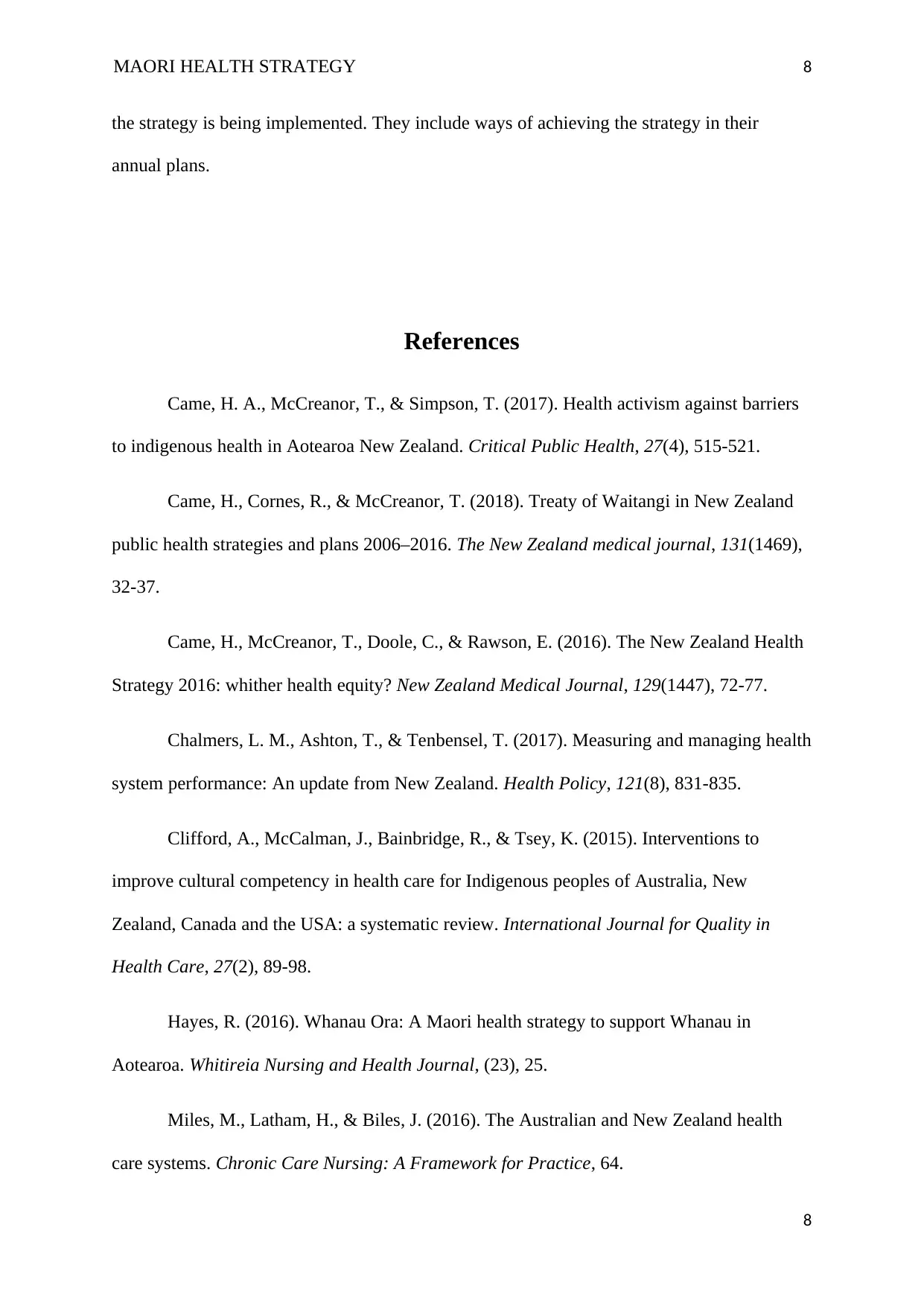
MAORI HEALTH STRATEGY 8
the strategy is being implemented. They include ways of achieving the strategy in their
annual plans.
References
Came, H. A., McCreanor, T., & Simpson, T. (2017). Health activism against barriers
to indigenous health in Aotearoa New Zealand. Critical Public Health, 27(4), 515-521.
Came, H., Cornes, R., & McCreanor, T. (2018). Treaty of Waitangi in New Zealand
public health strategies and plans 2006–2016. The New Zealand medical journal, 131(1469),
32-37.
Came, H., McCreanor, T., Doole, C., & Rawson, E. (2016). The New Zealand Health
Strategy 2016: whither health equity? New Zealand Medical Journal, 129(1447), 72-77.
Chalmers, L. M., Ashton, T., & Tenbensel, T. (2017). Measuring and managing health
system performance: An update from New Zealand. Health Policy, 121(8), 831-835.
Clifford, A., McCalman, J., Bainbridge, R., & Tsey, K. (2015). Interventions to
improve cultural competency in health care for Indigenous peoples of Australia, New
Zealand, Canada and the USA: a systematic review. International Journal for Quality in
Health Care, 27(2), 89-98.
Hayes, R. (2016). Whanau Ora: A Maori health strategy to support Whanau in
Aotearoa. Whitireia Nursing and Health Journal, (23), 25.
Miles, M., Latham, H., & Biles, J. (2016). The Australian and New Zealand health
care systems. Chronic Care Nursing: A Framework for Practice, 64.
8
the strategy is being implemented. They include ways of achieving the strategy in their
annual plans.
References
Came, H. A., McCreanor, T., & Simpson, T. (2017). Health activism against barriers
to indigenous health in Aotearoa New Zealand. Critical Public Health, 27(4), 515-521.
Came, H., Cornes, R., & McCreanor, T. (2018). Treaty of Waitangi in New Zealand
public health strategies and plans 2006–2016. The New Zealand medical journal, 131(1469),
32-37.
Came, H., McCreanor, T., Doole, C., & Rawson, E. (2016). The New Zealand Health
Strategy 2016: whither health equity? New Zealand Medical Journal, 129(1447), 72-77.
Chalmers, L. M., Ashton, T., & Tenbensel, T. (2017). Measuring and managing health
system performance: An update from New Zealand. Health Policy, 121(8), 831-835.
Clifford, A., McCalman, J., Bainbridge, R., & Tsey, K. (2015). Interventions to
improve cultural competency in health care for Indigenous peoples of Australia, New
Zealand, Canada and the USA: a systematic review. International Journal for Quality in
Health Care, 27(2), 89-98.
Hayes, R. (2016). Whanau Ora: A Maori health strategy to support Whanau in
Aotearoa. Whitireia Nursing and Health Journal, (23), 25.
Miles, M., Latham, H., & Biles, J. (2016). The Australian and New Zealand health
care systems. Chronic Care Nursing: A Framework for Practice, 64.
8
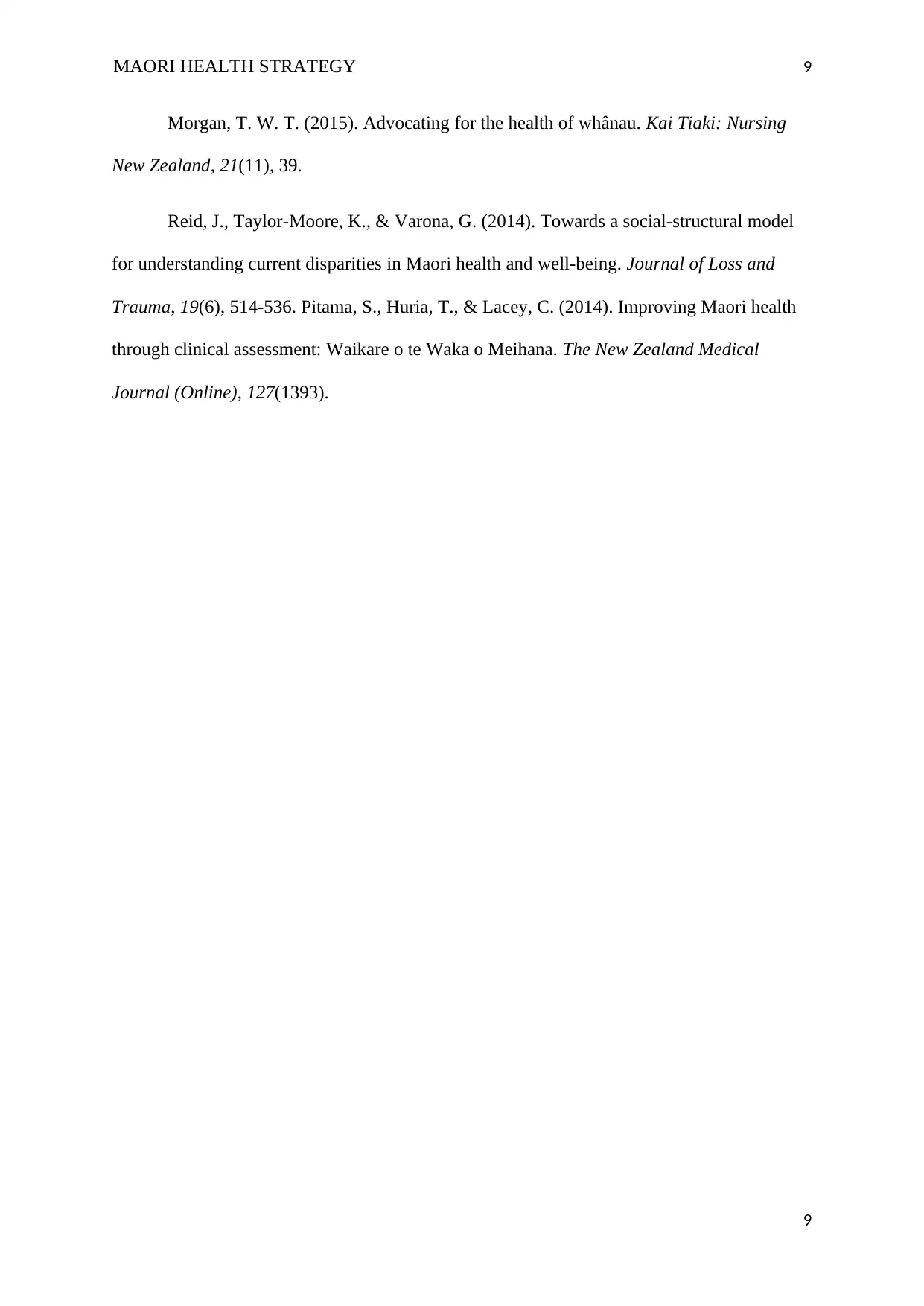
MAORI HEALTH STRATEGY 9
Morgan, T. W. T. (2015). Advocating for the health of whânau. Kai Tiaki: Nursing
New Zealand, 21(11), 39.
Reid, J., Taylor-Moore, K., & Varona, G. (2014). Towards a social-structural model
for understanding current disparities in Maori health and well-being. Journal of Loss and
Trauma, 19(6), 514-536. Pitama, S., Huria, T., & Lacey, C. (2014). Improving Maori health
through clinical assessment: Waikare o te Waka o Meihana. The New Zealand Medical
Journal (Online), 127(1393).
9
Morgan, T. W. T. (2015). Advocating for the health of whânau. Kai Tiaki: Nursing
New Zealand, 21(11), 39.
Reid, J., Taylor-Moore, K., & Varona, G. (2014). Towards a social-structural model
for understanding current disparities in Maori health and well-being. Journal of Loss and
Trauma, 19(6), 514-536. Pitama, S., Huria, T., & Lacey, C. (2014). Improving Maori health
through clinical assessment: Waikare o te Waka o Meihana. The New Zealand Medical
Journal (Online), 127(1393).
9
⊘ This is a preview!⊘
Do you want full access?
Subscribe today to unlock all pages.

Trusted by 1+ million students worldwide
1 out of 9
Related Documents
Your All-in-One AI-Powered Toolkit for Academic Success.
+13062052269
info@desklib.com
Available 24*7 on WhatsApp / Email
![[object Object]](/_next/static/media/star-bottom.7253800d.svg)
Unlock your academic potential
Copyright © 2020–2025 A2Z Services. All Rights Reserved. Developed and managed by ZUCOL.





